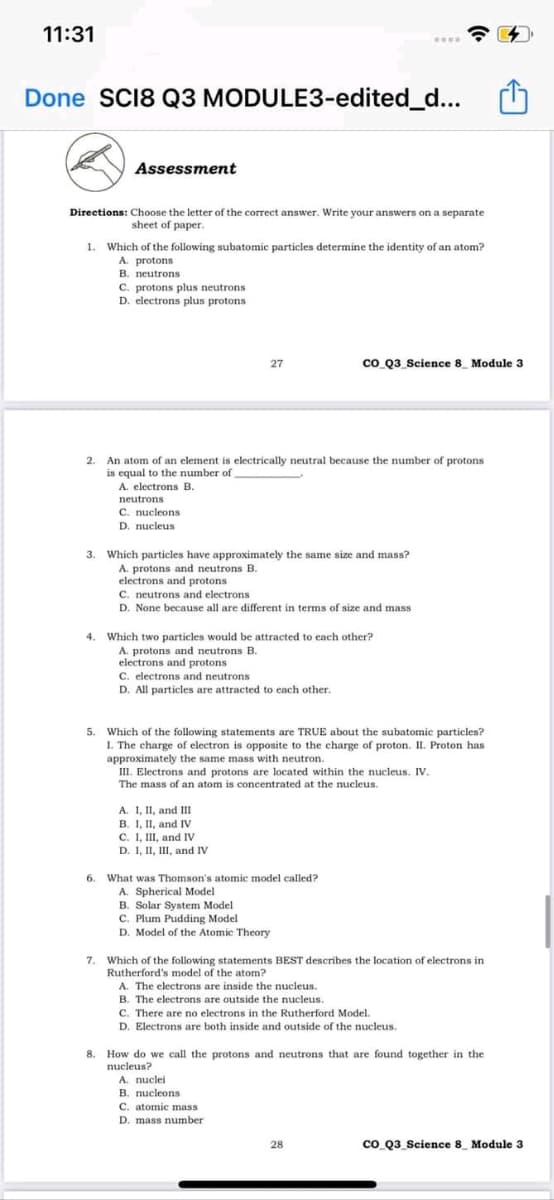1. Which of the following subatomic particles determine the identity of an atom? A protons B. neutrons C. protons plus neutrons D. electrons plus protons co Q3 Science 8 Module 3 27 2. An atom of an element is electrically neutral because the number of protons is equal to the number of A electrons B. neutrons C. nucleons D. nucleus 3. Which particles have approximately the same size and mass? A. protons and neutrons B. electrons and protons C. neutrons and electrons D. None because all are different in terms of size and mass
1. Which of the following subatomic particles determine the identity of an atom? A protons B. neutrons C. protons plus neutrons D. electrons plus protons co Q3 Science 8 Module 3 27 2. An atom of an element is electrically neutral because the number of protons is equal to the number of A electrons B. neutrons C. nucleons D. nucleus 3. Which particles have approximately the same size and mass? A. protons and neutrons B. electrons and protons C. neutrons and electrons D. None because all are different in terms of size and mass
College Physics
1st Edition
ISBN:9781938168000
Author:Paul Peter Urone, Roger Hinrichs
Publisher:Paul Peter Urone, Roger Hinrichs
Chapter34: Frontiers Of Physics
Section: Chapter Questions
Problem 26CQ: Not only is liquid nitrogen a cheaper coolant than liquid helium, its boiling point is higher (77 K...
Related questions
Question
1 2 3
Letter only

Transcribed Image Text:11:31
Done SCI8 Q3 MODULE3-edited_d...
Assessment
Directions: Choose the letter of the correct answer. Write your answers on a separate
sheet of paper.
1. Which of the following subatomic particles determine the identity of an atom?
A. protons
B. neutrons
C. protons plus neutrons
D. electrons plus protons
27
co Q3_Science 8 Module 3
An atom of an element is electrically neutral because the number of protons
is equal to the number of
A. electrons B.
2.
neutrons
C. nucleons
D. nucleus
Which particles have approximately the same size and mass?
A. protons and neutrons B.
electrons and protons
C. neutrons and electrons
D. None because all are different in terms of size and mass
3.
4. Which two particles would be attracted to each other?
A. protons and neutrons B.
electrons and protons
C. electrons and neutrons
D. All particles are attracted to cach other.
5.
Which of the following statements are TRUE about the subatomic particles?
I. The charge of electron is opposite to the charge of proton. II. Proton has
approximately the same mass with neutron.
III. Electrons and protons are located within the nucleus. IV.
The mass of an atom is concentrated at the nucleus.
A. 1, II, and II
B. I, II, and Iv
C. I, II, and IV
D. I, II, II, and IV
6.
What was Thomson's atomic model called?
A. Spherical Model
B. Solar System Model
C. Plum Pudding Model
D. Model of the Atomic Theory
7. Which of the following statements BEST describes the location of electrons in
Rutherford's model of the atom?
A. The electrons are inside the nucleus.
B. The electrons are outside the nucleus.
C. There are no electrons in the Rutherford Model.
D. Electrons are both inside and outside of the nucleus.
8. How do we call the protons and neutrons that are found together in the
nucleus?
A. nuclei
B. nucleons
C. atomic mass
D. mass number
28
co Q3_Science 8_ Module 3
Expert Solution
This question has been solved!
Explore an expertly crafted, step-by-step solution for a thorough understanding of key concepts.
This is a popular solution!
Trending now
This is a popular solution!
Step by step
Solved in 3 steps

Knowledge Booster
Learn more about
Need a deep-dive on the concept behind this application? Look no further. Learn more about this topic, physics and related others by exploring similar questions and additional content below.Recommended textbooks for you

College Physics
Physics
ISBN:
9781938168000
Author:
Paul Peter Urone, Roger Hinrichs
Publisher:
OpenStax College

Astronomy
Physics
ISBN:
9781938168284
Author:
Andrew Fraknoi; David Morrison; Sidney C. Wolff
Publisher:
OpenStax

Horizons: Exploring the Universe (MindTap Course …
Physics
ISBN:
9781305960961
Author:
Michael A. Seeds, Dana Backman
Publisher:
Cengage Learning

College Physics
Physics
ISBN:
9781938168000
Author:
Paul Peter Urone, Roger Hinrichs
Publisher:
OpenStax College

Astronomy
Physics
ISBN:
9781938168284
Author:
Andrew Fraknoi; David Morrison; Sidney C. Wolff
Publisher:
OpenStax

Horizons: Exploring the Universe (MindTap Course …
Physics
ISBN:
9781305960961
Author:
Michael A. Seeds, Dana Backman
Publisher:
Cengage Learning

University Physics Volume 3
Physics
ISBN:
9781938168185
Author:
William Moebs, Jeff Sanny
Publisher:
OpenStax